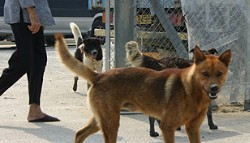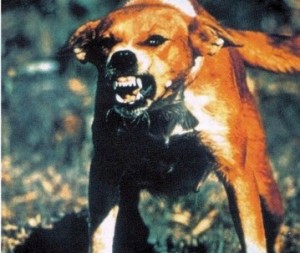 Rabies is a rabid and fatal disease that affects all animals that are warm blooded which includes humans as well. Rabies is rarely seen occurring in rodents. It is rare to find instances of rabies in cats and dogs in the United States due to the widespread vaccination procedures. However, rabies is still rampant among the wild animals in the United States as well as across the globe.
Rabies is a rabid and fatal disease that affects all animals that are warm blooded which includes humans as well. Rabies is rarely seen occurring in rodents. It is rare to find instances of rabies in cats and dogs in the United States due to the widespread vaccination procedures. However, rabies is still rampant among the wild animals in the United States as well as across the globe.
Symptoms of rabies in dogs
Rabies usually occurs in three stages, i.e., the prodromal stage, the furious or aggressive stage and the paralytic stage.
The prodromal stage is rarely seen in dogs. The last two stages of rabies are most dominant in dogs affected with rabies.
The prodromal stage can last up to six months. During this period the virus travels to the brain and slowly spreads across the nervous system. Dogs may not elicit any signs or symptoms during this stage of rabies. Some of the common symptoms of the prodromal stage include:
- Lethargy or tiredness
- Fever
- Loss of appetite
- Changes in the tone of bark
- Behavioral changes
- The bite area or site may be subject of constant and persistent chewing
The furious or the aggressive stage tends to last for a period of four to seven days. This is the most dangerous stage as the dog infected with the virus can spread the disease. The infected dogs tend to act insane, are prone to sudden attacks and chew and eat indigestible items such as stones and wood. Some of the signs and symptoms of the furious stage include:
- Behavior that elicits extreme aggressiveness and meanness
- Restlessness
- The dog may become completely uncontrollable
- Seizures
- The chewing and biting of inedible objects result in tooth loss or breakage
- Unprovoked biting without warning
- Dilated pupils leading to eye discharge
- Confusion or disorientation
- Constant and persistent growling
The dumb or the paralytic stage can last for three to ten days. Some of the symptoms include:
- Paralysis of the throat, the chewing muscles and the jaw that lead to increased salivation and drooling in the affected dogs
- Inability to swallow, which seems like the affected dogs are choking or they have something wedged in their throats.
- Foaming at the mouth
- Loss of coordinated muscle or motor movements causes the affected dogs to bump into objects.
- Dropping of the lower jaw
The paralytic stage culminates in a coma, respiratory difficulties and failure and eventual death.
Causes of rabies in dogs
- The rabies virus causes rabies in dogs. It is transmitted from the saliva of an infected dog or other animals.
- An infected dog can transmit the disease even with the slightest of touches of its saliva to an open wound or scratch or a damaged mucous membrane
- In the United States, there are not very many instances of humans getting infected with rabies virus through the bites or scratches of dogs or cats. However, this is not the scenario in other countries wherein rabies is endemic and is usually caused due to dog bites.
Treatment of rabies in dogs
- The vaccination programs and procedures for dogs and other domesticated animals have been very successful throughout the United States.
- It is important to remember that any canine that is bitten by any other animal can be infected with rabies if one is not absolutely sure that the other animal is not a carrier of the rabies virus. This should be the case in all cases of animal bites, until one can prove the absence of rabies in the animal that has bit.
- In case a dog has been bitten by another dog or animal, it is essential to thoroughly cleanse all the scratches and wounds on the dog. The cleansing and washing should be done with clean soap and water. One must not forget to wear gloves during the cleansing process. The wounds should remain open and not stitched together. Research studies have proven that immediate and prompt cleaning of the bite wounds go a long way in the prevention of rabies in dogs that are bitten.
- After the washing of the wounds, a dog that has been previously vaccinated should be administered a prophylaxis that contains a booster shot.
- As per the guidelines of the National Association of State Public Health Veterinarians, it is essential to revaccinate a dog that has been bitten. After that, the dog should be observed under leash confinement for up to forty five days. In case the dog has not been vaccinated against rabies, then the bitten dog must either be euthanized or placed in confined with strict quarantine for at least six months. During such quarantine, there should be no human handling of the dog or its contact with other animals. Five months after the biting incident the dog must be vaccinated and then replaced under confined observation for another month.
- In order to prevent rabies in dogs, it is essential to vaccinate the dogs within three to six months and with a booster shot a year later. The booster shots have to be given again every one to three years to prevent rabies in dogs.
Rabies Symptoms in dogs pictures


Hi I just want to ask if am I still at risk when my dog attact me my lips in particular but I don’t know if he bit me or just his nails that causes me to bleed it happened so fast and I covered my eyes to protect that’s why I wasnt able to see what penetrated to the skin, though he was already injected with anti rabbies last December he was a clean dog he stay inside the house all the time he eats clean water and food. He was a good dog well taught it happens only because he wants attention and i was doing someting, actually he always ask for attention but thats the only time he get to hurt me badly What if I was bitten am I still at risk even if he was clean and was injected with anti rabbies? Thank you
Howdy! Someone in my Myspace group shared this site with us so I came to check it out. I’m definitely loving the information. I’m bookmarking and will be tweeting this to my followers! Exceptional blog and fantastic design and style.